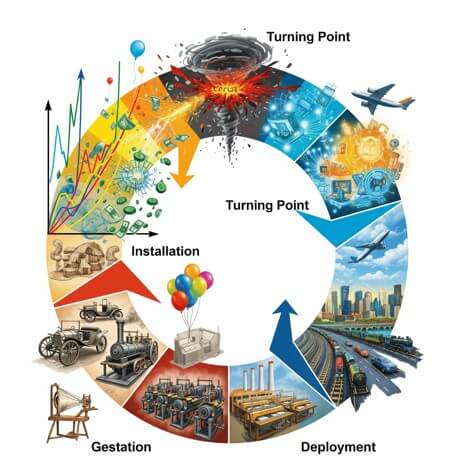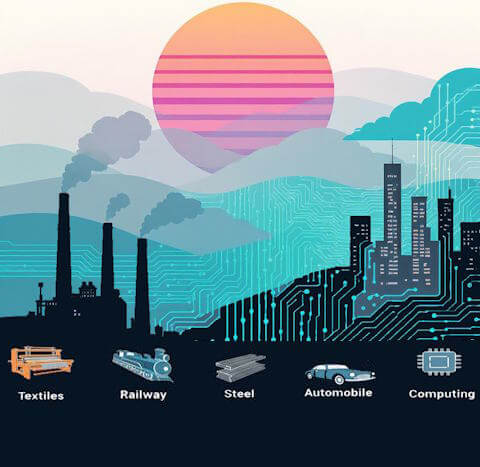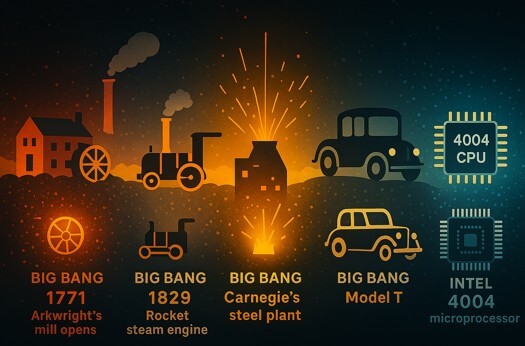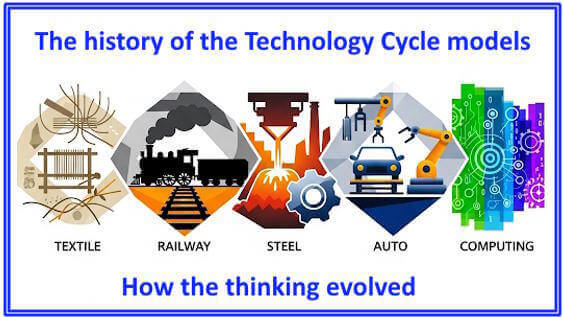
Sitemap

The Five Technology Cycles:
The information is presented from a structural perspective.
The five cycles, periods, and phases are outlined showing the common impacts, and the changes created by the structural elements.
Therefore, the common impacts are listed and gone through for all five technology cycles.
This is the most straightforward way to illuminate how repetitive these cycles have always been.
The periods and phases correspond to Carlota Perez’s technological cycle breakthrough framework.
The Structural Impact views follow

Disruptions Dawn:
From Steam to Silicon presented structurally.
This framework meticulously analyzes five pivotal “Big Bang” events—Arkwright’s textile revolution, Stephenson’s railway empire, Carnegie’s steel transformation, Ford’s automotive breakthrough, and the IBM Intel computing explosion—to uncover the ten critical dimensions that determine whether an innovation becomes a footnote or a force of nature.
Brian Arthur revealed how innovations emerge from complex ecosystems with intricate technological lineages. Carlota Perez mapped the grand cycles of technological transformation that constantly remake civilization.
Applying Arthur’s and Perez’s logic, this book identifies ten critical dimensions that revolutionary innovations have in common.
This book analyzed the history and found ten common dynamics that underpin Perez and Arthur’s frameworks. The interlocking feedback loops are brought into clear view.
Enter: Disruptions Dawn
Chapter One: Infrastructure Creation
Chapter Two: Disruptive Cost Curve Shifts
Chapter Three: Systematic Codification
Chapter Four: Labor Organization
Chapter Five: New Markets
Chapter Six: Innovation Clustering
Chapter Seven: Socioeconomic readiness
Chapter Eight: Capital Alignment
Chapter Nine: Market Alignment
Chapter Ten: Political & Institutional Alignment
Chapter Eleven: Relevance & Impacts
The Chronological Perspective

The Five Technology Cycles:
The five technology cycles presented chronologically.
The periods and phases are outlined, beginning with the first technology cycle, and then laid out linearly, moving through the four succeeding technology cycles. The periods and phases all correspond to Carlota Perez’s breakthrough framework for technology cycles.
The Linear – Chronological Views
— Cycle One (the Industrial Revolution): 1730s to 1829
—- Gestation/Core Formation: 1730 to 1771
—- Installation Period: 1771 to 1793
—- Turning Point: 1793 to 1798
—- Deployment Period: 1798 to 1829
— Cycle Two (the second industrial revolution – the rail revolution): 1800s to 1875
—- Gestation/Core Formation: 1800 to 1829
—- Installation Period: 1829 to 1848
—- Turning Point: 1848 to 1850
—- Deployment Period: 1850 to 1875
— Cycle Three (Steel & Electricity revolutions): 1840s to 1908
—- Gestation/Core Formation: 1870s to 1908
—- Installation Period: 1875 to 1893
—- Turning Point: 1848 to 1850
—- Deployment Period: 1850 to 1875
— Cycle Four (Autos & Oil revolutions -Internal Combustion Engine): 1870s to 1971
—- Gestation/Core Formation: 1870s to 1908
—- Installation Period: 1908 to 1929
—- Turning Point: 1929 to 1933/43 (US only)
—- Deployment Period: 1929/43 to 1971
— Cycle Five (Microprocessor & Telecommunications Revolutions): 1940s to ?
—- Gestation/Core Formation: 1940s to 1971
—- Installation Period: 1971 to 2000
—- Turning Point: 2000s to ? – Currently in Progress
—- Deployment Period: ? to ?
Currently in process

The Evolution of the Models/Frameworks
The thinking was produced under very unusual conditions. However, it has been built out to levels both George Box and Brian Arthur would describe as useful. Actually, Brian Arthur has already endorsed Perez’s framework.
